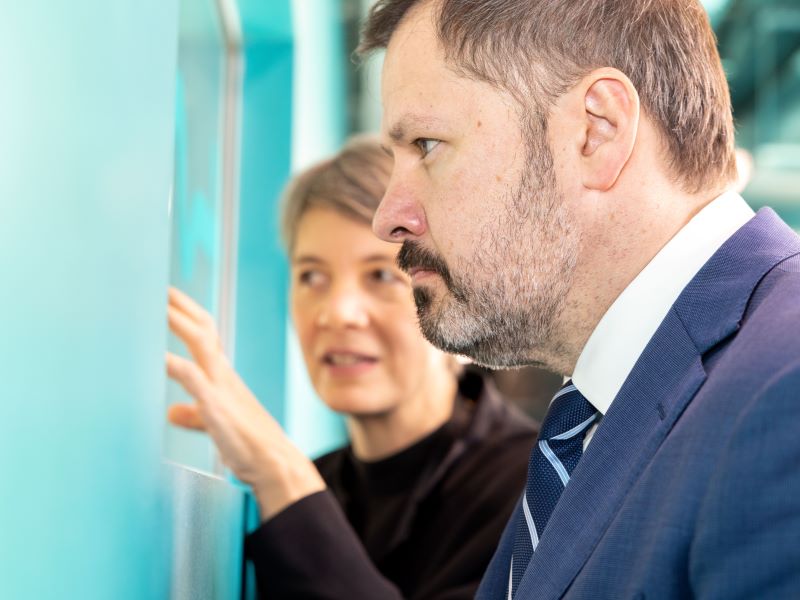Australia’s emerging quantum industry has applauded the ambition of the federal government’s National Quantum Strategy, although some have urged caution against too much focus on engineering and commercialisation, saying there is still plenty of fundamental research to be done.
For ambition, Industry and Science Minister Ed Husic was given full marks from industry in launching the quantum strategy on Wednesday, which included a commitment that Australia would build a first-in-the-world error corrected quantum computer within ten years.
Silicon Quantum Computing chief executive and Bakerian Medalist Professor Michelle Simmons – whose company is building a full-stack error-corrected quantum computer at its facilities in Sydney – told InnovationAus.com on the sidelines of the launch that to a very large extent “ambition is the strategy”.

The National Quantum Strategy is a well-constructed document and a welcome blueprint Professor Simmons said, but it is national ambition that will enable it.
“It is refreshing and positive for the country to have an industry minister with vision who is prepared to act decisively,” she said.
“All leading nations globally are aware of the strategic importance of quantum computing and have invested heavily in it. Australia has a leadership position that has to be maintained.
“Our chief scientist has worked extremely hard on the strategy. She put together something that is comprehensive and rigorously thought through.
“At SQC, we are manufacturing the world’s smallest electronic devices so that we can build an error-corrected quantum computer here in Australia.
“It is important to us that we have a supportive policy environment. This strategy will help deliver that.”
Venture capital-backed quantum tech company Q-CTRL’s head of government engagement Charlie Burnard said the quantum strategy was the start, but sustained ambition is required: “As the minister has made clear, the release of the strategy today is the beginning of the journey not the end.”
“Realising its full potential and turning ambition into outcomes will require whole of nation support, close cooperation and coordination at all levels of government, and sustained, meaningful backing for the sector,” Mr Burnard said.
Quantum Brilliance chief executive officer Mark Luo said the approach taken in the National Quantum Strategy is consistent with successful models used by the likes of the US and UK, with patient government investment as a crucial part of commercialisation.
Mr Luo said the most encouraging thing about the strategy was its commitment to ensuring the availability of quantum infrastructure.
“To be successful, we need to build infrastructure for quantum hardware, quantum computing prototyping and integration hub, and quantum materials,” he said.
“As an example, the [quantum strategy] heavily features diamond quantum technology as an area of global strength in Australia and particularly Victoria. The area of nanofabrication for quantum materials presents an opportunity for Australia to develop sovereign capability to support its quantum industry.”
“This could be through the establishment of a national quantum hub for materials, naturally integrating with tertiary research sector, to concentrate and consolidate materials development and supply chains globally.”
University of Sydney deputy-vice chancellor for research Professor Emma Johnston said it was “heartening” to see the ambition underpinning the strategy, but pointed to the need for ongoing fundamental research in quantum technologies.
“Combined with continued and deepening investment in fundamental research through the Australian Research Council and other government initiatives, this can deliver a positive platform to deliver Australia’s quantum future,” she said.
The head of the university’s Quantum Theory Group and associate dean in the faculty of science, Dr Stephen Bartlett, said it remained “vital” that the government continues its strong investment in fundamental quantum science research.
“Delivering on the promise of quantum computing still requires us to tackle big open challenges in basic science and engineering,” he said. “That’s why the University of Sydney is investing in the Future Qubit Foundry. Tomorrow’s quantum computers will use qubits that are yet to be invented.”
Technology Council of Australia chief executive Kate Pounder said the release of the strategy was a pivotal step in cementing Australia’s leadership in quantum. The Tech Council is home to the Australian Quantum Alliance industry grouping.
“Quantum technology is at an inflection point. Australia is a leader in the research and development of quantum technology. We have built leading homegrown companies, and attracted some of the world’s leading global companies in quantum to undertake research in Australia,” she said.
“The strategy builds on the momentum from the Australian Government’s $1 billion commitment to critical technologies under the National Reconstruction Fund, the recent announcement of a $3.4 billion Advanced Strategic Capabilities Accelerator in response to the Defence Strategic Review, and the Australian Quantum Graduates Program,” she said.
“Our challenge is to now become a leader in commercialisation. Early commercialisation will deliver billions of dollars in economic value and thousands of jobs by 2030.”
Do you know more? Contact James Riley via Email.

